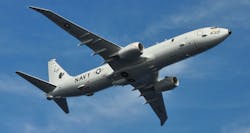Boeing to upgrade P-8A Poseidon aircraft open-systems electronics architecture for networking and weapons
PATUXENT RIVER NAS, Md. – U.S. Navy aerial surveillance experts are asking the Boeing Co. to provide upgrade kits to give the P-8A Poseidon maritime patrol jet aircraft a network-ready open-systems electronic architecture and network-enabled weapons under terms of a $14.2 million order announced Thursday.
Officials of the Naval Air Systems Command at Patuxent River Naval Air Station, Md., are asking the Boeing Defense, Space & Security segment in Seattle for Poseidon increment 3 block 1 retrofit kits for 24 existing P-8A aircraft.
The Poseidon's increment 3 focuses on network-ready open-systems electronics architecture and network-enabled weapons, and is part of the Navy's plan to replace its fleet of P-3 Orion turboprop maritime patrol aircraft with the Poseidon.
The Poseidon is a militarized version of the Boeing 737 single-aisle jetliner, while the much-older P-3 is a militarized version of the Lockheed Martin L-188 Electra four-engine turboprop passenger plan, which has been flying since the late 1950s.
Related: Progeny Systems continues work to upgrade P-8A mission software to open-systems standards
The P-8A Poseidon increment 3 block 1 retrofit kits will enable the aircraft to carry the Harpoon Block II+ anti-ship missile and Link 16 datalink, as well as communications upgrades.
The P-8A aircraft already in service will be retrofitted to the increment 3 standard. The P-8A is expected to have a completely upgraded software by 2022, in time to become fully operational in 2023. The Australian air force has committed to acquiring 15 P-8A Poseidon aircraft.
Boeing has been developing, integrating, and testing increment 3 block 1 upgrade kits since June 2016 when the company won a $71.6 million order to do so.
On this order Boeing will do the work in Seattle and in Mesa, Ariz., and should be finished by November 2022. For more information contact Boeing Defense, Space & Security online at www.boeing.com, or Naval Air Systems Command at www.navair.navy.mil.
About the Author
John Keller
Editor-in-Chief
John Keller is the Editor-in-Chief, Military & Aerospace Electronics Magazine--provides extensive coverage and analysis of enabling electronics and optoelectronic technologies in military, space and commercial aviation applications. John has been a member of the Military & Aerospace Electronics staff since 1989 and chief editor since 1995.
